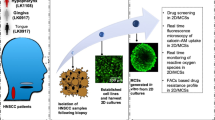Abstract
Misonidazole has been demonstrated to enhance the cytotoxicity of several common antineoplastic drugs in vitro and in vivo, and its mechanism of action as a chemosensitizer, though still unknown, is thought to be dependent upon hypoxia. We have used fluorescence-activated cell sorting to evaluate chemopotentiation by misonidazole as a function of cell position in V79 spheroids and KHT tumours. CCNU toxicity was enhanced in all cell subpopulations of both tumours and spheroids, with greater consistency than might be predicted on the basis of the known variations in oxygen tension. Further, both misonidazole and CCNU as single agents were preferentially toxic in the less well oxygenated regions of each system, arguing that differential toxicity cannot be implicated in the chemopotentiation observed. In fact, increased treatment toxicity did not necessarily lead to increased chemopotentiation, nor was potentiation directly related to the metabolism/binding of the misonidazole. Chemopotentiation in multicell systems thus appears to be a complex, multi-factorial process.
Similar content being viewed by others
Author information
Authors and Affiliations
Rights and permissions
About this article
Cite this article
Durand, R., Chaplin, D. Chemosensitization by misonidazole in CCNU-treated spheroids and tumours. Br J Cancer 56, 103–109 (1987). https://doi.org/10.1038/bjc.1987.165
Issue Date:
DOI: https://doi.org/10.1038/bjc.1987.165
- Springer Nature Limited




